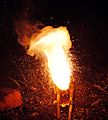Exothermic reaction facts for kids
An exothermic reaction is a special kind of chemical reaction where things that react together let out energy as heat. Think of it like a tiny explosion that makes things warmer! A common example is burning. These reactions send energy out into their surroundings. The opposite is an endothermic reaction, which soaks up heat instead.
Contents
What is an Exothermic Reaction?
When an exothermic reaction happens, it releases energy, usually as heat. This makes the stuff reacting, and everything around it, get hotter. You can even feel the temperature go up with a thermometer!
How Does Energy Get Released?
Inside every chemical substance, there's stored energy called "chemical energy." When an exothermic reaction takes place, the chemicals change. The new chemicals that are formed have less chemical energy stored in them than the original ones. The extra energy that isn't stored anymore is then released, usually as heat. This is why the surroundings get warmer!
Common Examples of Exothermic Reactions
You see exothermic reactions all the time in your daily life! Here are a few examples:
- Burning: When you light a fire, like burning wood or a candle, it releases a lot of heat and light. This is a classic exothermic reaction.
- Respiration: This is how your body gets energy from food. Inside your cells, food reacts with oxygen to release energy, which keeps you warm and helps you move.
- Neutralization Reactions: When an acid and an alkali (a type of base) mix, they react and often release heat. This is called a neutralization reaction.
- Water and Calcium oxide: When water is added to calcium oxide (also known as quicklime), it creates a lot of heat. This reaction is used in some self-heating food packages!
Images for kids
See also
 In Spanish: Reacción exotérmica para niños
In Spanish: Reacción exotérmica para niños


